- If the end walls are sufficiently strong, bracing is enough.
- If the end walls are weaker, the necessary securing forces can be achieved by a combination of bracing and lashing.
The sideways lashings are prepared before the cargo is set down:
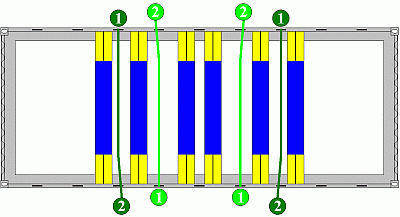 |
| Initial attachment and arrangement of loop lashings |
The lashing materials used, such as steel strapping, wire ropes, chains or the like, are attached to the lashing points (1) and the other ends are passed over to the opposite side (2), where they are laid down loose. For the slab which is to be secured, each loop lashing will require a length of approx. 5 m plus a little extra, the length of which will be determined by the materials used and how they are tensioned. The outermost crosswise supports, labeled (3) in the following diagram, at each end should in each case be laid so that they extend beyond the slab in the direction of the end wall. In this way, these wooden crosspieces can act as an abutment for the bracing towards the end walls of the flatrack.
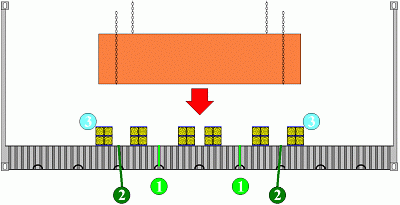 |
|
| Setting down the slab: (1) = attached ends of the loop lashings (2) = loose ends of the loop lashings (3) = wooden crosspieces protruding towards the end walls |
Once the cargo has been set down, the loose ends of the lashings (2) are each passed over the slab to the lashing points (4) on the other side of the flatrack. Before finally fastening the ends to these lashing points, the path taken by the loop lashings must be carefully checked. At the deflection points shown by the dotted arrows in the following diagram, the lashing means must be adjusted manually, preferably by a second person, so that the parts of the loop lashing running above and below the slab are symmetrical. In simple terms, the shortest path between the lashing points must be chosen. At no point during transport must it be possible for the lashing materials to shift or move of their own accord.
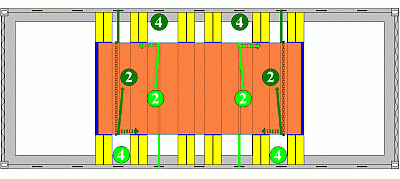 |
|
| Positioning and fastening of loop lashings |
Once properly fastened, the loop lashings look like this:
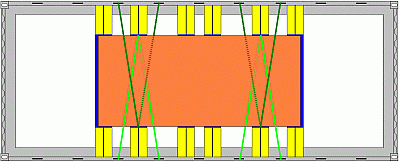 |
|
| Plan view - slab secured with two loop lashings on each side |
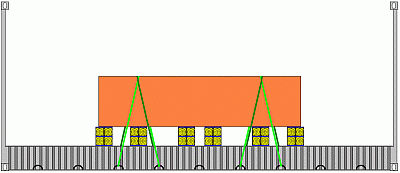 |
|
| Side view - slab secured with two loop lashings on each side |
The path taken by the loop lashings is clarified again in the following Figure:
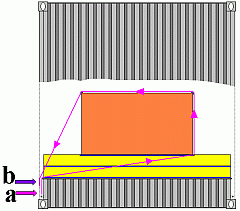 |
 |
|
| Front view - path of a loop lashing to one side | ||
Point a is the initial attachment point for all conventionally used cargo securing materials such as steel strapping, steel wire ropes, chains and "single-use" belts as well as prefabricated cargo securing materials such as lashing belts with ratchet tensioners, chains with integral tensioners etc. The loop lashing is passed from point a beneath the item of cargo to be secured. As already mentioned, this end is advantageously positioned before the item of cargo is loaded. Point b represents an adjacent lashing point with an identical or at least similar maximum securing load. The end of the loop lashing which has been passed over the cargo is attached to this point. When tighteners are used, they are attached to point b either directly or by means of additional aids.
If the lashing means, such as for example wire or belt reels, are an integral part of the flatrack or similar means of transport, there are two basic securing methods:
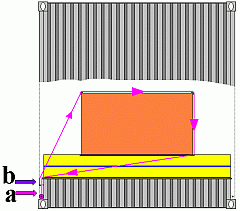 |
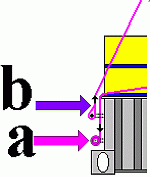 |
|
| Front view - path of a loop lashing to one side | ||
The belts are unwound from the reels and passed over to the other side. Once the cargo has been loaded, they are hooked on to the opposite side and tightened. As a result, tension is applied from below in this case. Of course, if desired, tension may also be applied from above. However, in this case, the cargo must first be loaded. The belts should then be passed over the slab, then returned to the same side under the slab and hooked in on that side. Clearly, this method is somewhat more awkward and time-consuming.
Using the quicker method, lateral securing of the slab would entail:
- positioning sandwich supports crosswise on the flatrack
- unrolling two belts from each side and pulling them over to the other side of the flatrack
- setting down the slab on the flatrack
- throwing the belts back over the slab to the starting side and hooking them into a load-bearing lashing point, taking care to ensure that the belts are not twisted and to pad sharp edges
- and finishing the job by tightening the ratchet tensioners.
Due to design shortcomings, this ideal type of securing is currently not yet possible.
Lashing reels arranged on only one side of the flatrack are not entirely suitable for providing securing with loop lashings.
 |
 |
|
| Flatrack with integral lashing reels and webbing belts | ||
In this case, using one of the methods described above, tension may be applied from above or below with the lashing reels on one side. If possible, webbing belts of the same maximum securing load and tightenable with conventional ratchet tensioners should be used to provide securing to the other side. If such tighteners are not available, it is also entirely feasible to use equivalent single-use belts which are pretensioned by special tighteners.